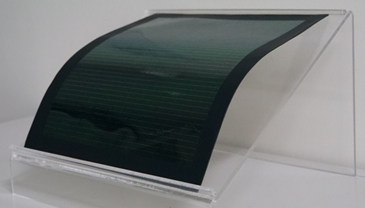Contributing to carbon-neutrality by advancing practical application of light and flexible next-generation photovoltaic modules that can be widely installed
TOKYO—Toshiba Corporation (TOKYO: 6502), the world-leader in development of perovskite photovoltaic modules for next-generation solar power generation, has developed a new coating method for the perovskite layer that boosts power conversion efficiency (PCE) to 15.1% for Toshiba’s 703cm2 module*1, the highest for any large, polymer film-based perovskite photovoltaic module*2. The innovative coating method for perovskite layer also greatly reduces production time and costs, contributing to a lower cost for solar power generation.
Success in achieving carbon neutrality will require much greater use of photovoltaic power generation, and a significant expansion in locations where photovoltaic modules can be installed. Today’s most widely used photovoltaic modules are made with crystalline silicon and are heavy, and this, plus their rigidity, limits where they can be installed. The polymer film-based perovskite photovoltaic module is an attractive next-generation alternative, as it is thin, light and flexible, and can be installed in locations where it is difficult to use silicon photovoltaic modules, such as low load-bearing roofs and office windows. Recent improvements in the PCE of perovskite photovoltaic modules has brought them to a level comparable to that of silicon photovoltaic modules.
Toshiba has developed a one-step meniscus coating method that uses improved ink, film drying processes and production equipment to form a uniform perovskite layer over an area as large as 703cm2. These innovations halve the steps for deposition of the perovskite layer, and raise the coating speed to 6 meters per minute on a 5×5 cm2 module, a rate that meets requirements for mass production*3 (Figure 2, left).
Applied to Toshiba’s previously reported 703cm2 polymer film-based perovskite photovoltaic modules, the one-step meniscus coating method achieves a PCE of 15.1%, the world’s highest ever for a polymer film-based large-area perovskite photovoltaic module. (Figure 2, right). This higher PCE and the faster, simplified production process, significantly advance progress toward the commercialization of highly efficient, low-cost, polymer film-based perovskite photovoltaic modules.
Toshiba’s latest breakthrough is the development of a new perovskite layer coating method. The company previously developed a two-step coating process that first applied a layer of PbI2 (lead iodide) ink to a substrate, followed by a layer of MAI (methyammonium iodide, CH3NH3I) ink, triggering a reaction that formed an MAPbI3 layer. However, this multi-step approach had a low coating rate and often left unreacted sections in the perovskite layer (Figure 1, left). The alternative is a one-step process that applies MAPbI3 ink directly, but it is not easy to control crystallization of the MAPbI3 and obtain a uniform perovskite layer across a large area (Figure 1, right). A new coating method that solves these problems was required.
Toshiba estimates that the new perovskite photovoltaic modules would generate power equivalent to two-thirds of the annual power consumption by homes in Tokyo*4 if installed on a roof area of 164.9km2, roughly equal to the roof surface area of all buildings in Tokyo*5.
Toshiba will continue research on perovskite photovoltaic modules, aiming to increase PCE to 20% or more, and to enlarge the active area to 900cm2, the size required for practical application. The company estimates achieving these targets will cut the manufacturing cost of perovskite photovoltaic modules to \15/W (approx. $0.14/W).
The newly developed coating technology and the perovskite solar modules that apply it are research results under a New Energy and Industrial Technology Development Organization (NEDO) project, Development of Technologies to Promote Photovoltaic Power Generation as a Main Power Source.
Notes
*1 The active area is 24.15cm x 29.10cm (702.765cm2)
*2 Toshiba survey of 100cm2 or larger film-based perovskite solar modules with a plastic substrate (9/10/2021)
*3 Toshiba’s survey.
*4 2018 annual power consumption by homes in Tokyo: 26×109kWh.
Source: Agency for Natural Resources and Energy, Ministry of Economy, Trade and Industry.https://www.enecho.meti.go.jp/statistics/energy_consumption/ec002/results.html
*5 Toshiba estimate. Total roof area (164.9km2) in Tokyo: J. Archit. Plann, AIJ, No. 581, 83−88, Jul., 2004https://www.jstage.jst.go.jp/article/aija/69/581/69_KJ00004229303/_pdf
About Toshiba
Toshiba Corporation leads a global group of companies that combines knowledge and capabilities from over 140 years of experience in a wide range of businesses—from energy and social infrastructure to electronic devices—with world-class capabilities in information processing, digital and AI technologies. These distinctive strengths support Toshiba’s continued evolution toward becoming an Infrastructure Services Company that promotes data utilization and digitization, and one of the world’s leading cyber-physical-systems technology companies. Guided by the Basic Commitment of the Toshiba Group, “Committed to People, Committed to the Future,” Toshiba contributes to society’s positive development with services and solutions that lead to a better world. The Group and its 120,000 employees worldwide secured annual sales surpassing 3.1 trillion yen (US$27.5 billion) in fiscal year 2020. Find out more about Toshiba at www.global.toshiba/ww/outline/corporate.html



























